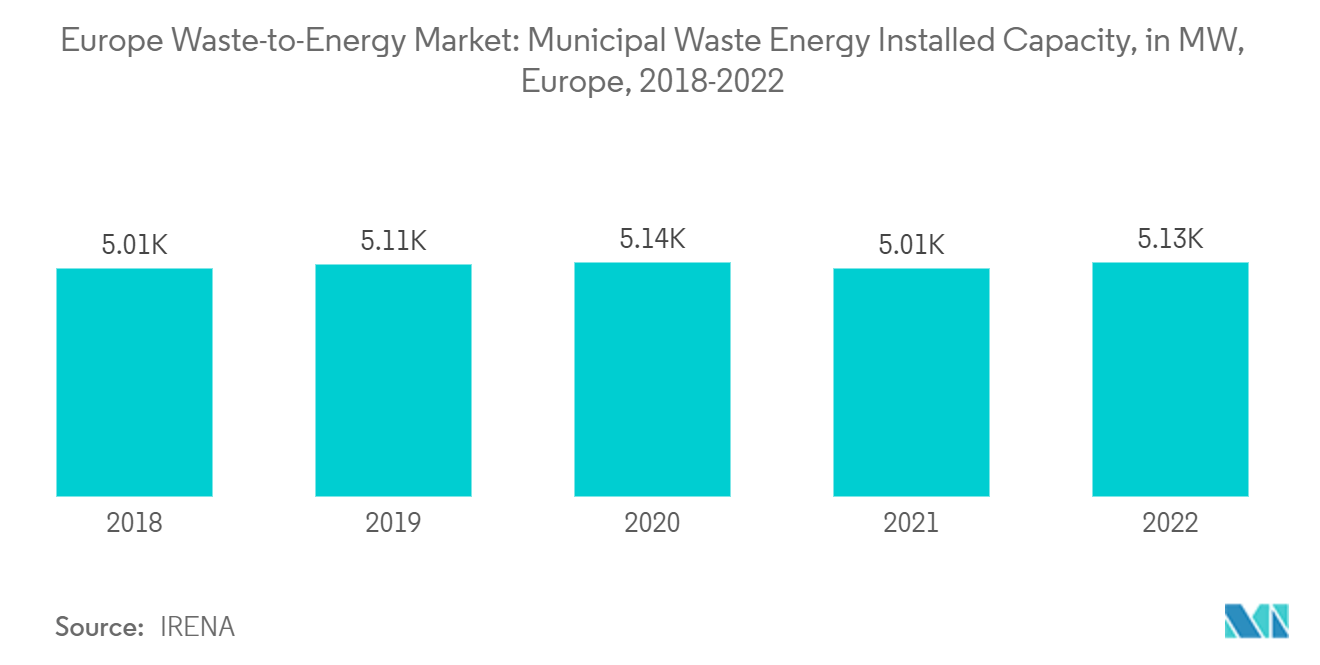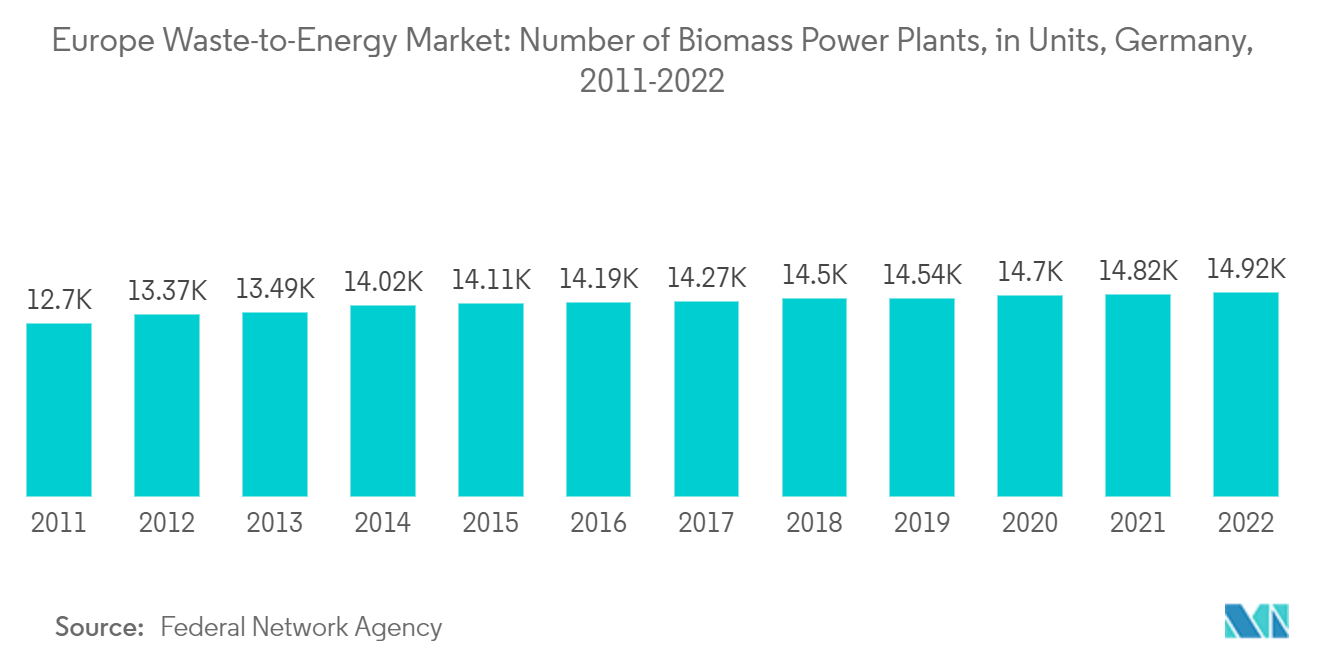Market Trends of Europe Waste-to-Energy Industry
Thermal-based Waste-to-Energy Segment to Dominate the Market
- In the thermal process, waste is treated to generate heat, which is used to generate energy or produce fuel oil or syngas from organic and inorganic wastes. Further, the thermal process may involve combustion, pyrolysis, thermal gasification, or plasma arc gasification.
- Incineration is the most well-known WtE technology for Municipal Solid Waste (MSW) processing in the present scenario. Gasification and pyrolysis processes produce combustible synthetic gas (syngas) that can either be used to generate electricity or further be refined and upgraded for direct generation in a gas turbine or engine. The electrical efficiency rate from incineration is usually higher than that from gasification due to lower operating temperatures, steam pressure, and overall energy required to run the plant. It is estimated that plants that utilize cogeneration of thermal power (heating and cooling), together with electricity generation, can reach an optimum efficiency of 80%.
- WtE technologies, particularly incineration, produce pollution and carry potential health safety risks. The following air emissions are associated with incineration facilities - metals, organics, acid gases, particulates, nitrogen oxides, and carbon monoxide. These incinerators have been highly scrutinized by NGO activists, public health agencies, and the general public and influenced the legislators to impose stricter limits on emissions. To reduce particulate and gas-phase emissions, incineration plant owners have adopted a series of process units for cleaning the flue gas stream, and this has, in turn, led to a significant improvement in terms of environmental sustainability.
- Gasification of waste produces reduced emissions per unit of the generated power, compared to both incineration and landfilling. If focused on the number of pollutant emissions per unit of treated waste, gasification is the preferred option, while incineration is considered to be the most harmful.
- Thermal technology continues to dominate the waste-to-energy market in Europe, accounting for a major share of the market. Recent developments in incineration and gasification technology are one of the essential factors driving the waste-to-energy market in Europe.
- In recent years, Italy has also been witnessing progress in WtE incineration facilities integrated with other technologies in the country to meet the demands of recycling or recovering energy. For instance, in February 2023, Maire Tecnimont S.p.A. announced that its subsidiary NextChem was awarded a feasibility study by the Foresight Group for a carbon capture (CC) and sustainable methanol synthesis plant in the ETA Manfredonia waste-to-energy (WtE) plant in Puglia, a Southeastern Italian region. Upon completion of the study, the successful finalization of the permitting process, and the following final investment decision, the execution of the engineering and construction phases will be carried out by Maire Tecnimont Group.
- According to the International Renewable Energy Agency (IRENA), the total municipal waste energy installed capacity in Europe stood at around 5134 MW in 2022, which witnessed a growth of 2.37% from the previous year.
- Thus, due to the abovementioned factors, thermal-based waste-to-energy conversion is expected to lead the market. The rising urban population contributes to increasing municipal solid waste (MSW) in Europe.

Germany is Expected to be the Fastest-growing Market
- Germany is among the most populous and a leading economy in Europe. The rapid urbanization in the country has led to increased electricity demand, thereby leading to notable investment in new energy generation plants. Moreover, the electricity consumption in Germany is set to rise from around 546.5 terawatt-hours (TWh) in 2022 to 880 TWh in 2040, which is likely to provide opportunities for WtE plants in the coming years. However, the growing renewable power sources such as solar and wind are likely to be significant power sources in the future. They are anticipated to decrease the purpose of WtE incineration.
- In 2022, around 46% of the total electricity in Germany was produced by renewable energy, which is in line with the country's recent aim of renewable power generation to account for 80% of its energy mix by 2030, as it abandons nuclear power and aims to reduce most of its coal generation. Moreover, Germany aims to reach climate neutrality by 2045 and achieve negative greenhouse gas emissions after 2050. To achieve its ambitious targets, Germany is likely to advance emission reductions in all sectors, including the power industry. Though the WtE technologies make use of the waste and generate useful energy, incineration is likely to remain a contributor to the CO2 emitter. This is likely to make WtE incineration projects less attractive in the future.
- Nevertheless, Germany has seen a notable development in waste-to-energy incineration over the past years, and the country dominated the market across the European region. According to the International Renewable Energy Agency (IRENA), the municipal waste-to-energy installed capacity in Germany stood at around 1068 MW in 2022, which is one of the highest in Europe. However, it saw no change from the previous year.
- Moreover, biomass wastes can be converted into clean energy and fuels by various technologies, ranging from conventional combustion processes to state-of-the-art thermal depolymerization technology. Excluding recovery of substantial energy, these technologies can lead to a significant reduction in the general waste quantities needing final disposal, which can be better managed for safe disposal in a controlled manner while meeting pollution control standards.
- According to the Federal Network Agency, as of 2022, there were 14,922 biomass power plants across Germany. This figure denotes a peak in the number of biomass power plants in the country.
- Further, in Germany, geothermal power has also been explored along with the waste-to-energy (WtE) plants. For example, in May 2023, the waste-to-energy plant in the town of Geiselbullach in the municipality of Olching in Bavaria, Germany, is aiming to tap into geothermal resources to provide an alternative source for the existing district heating network. This is based on an application filed by Gemeinsames Unternehmen für Abfallwirtschaft (GfA), the joint municipal company for waste management, to search for geothermal resources on its property.
- Therefore, factors such as the increasing amount of waste generated and increasing waste-to-energy plants in Germany during the forecast period may drive the market in the country.

